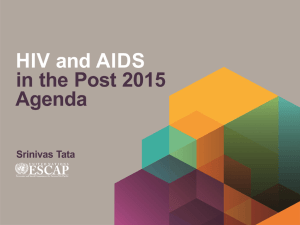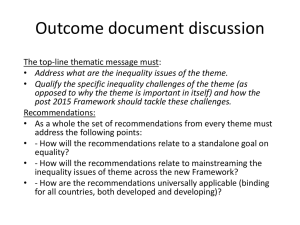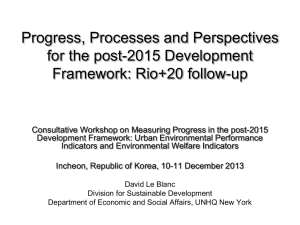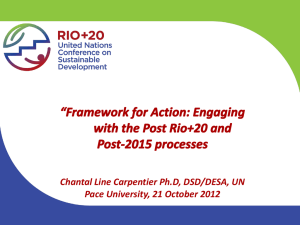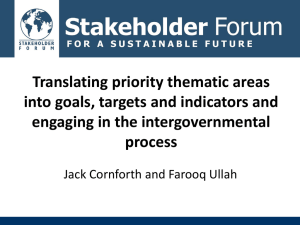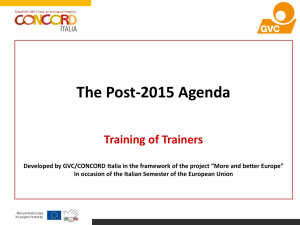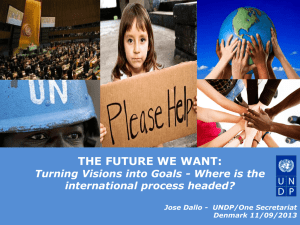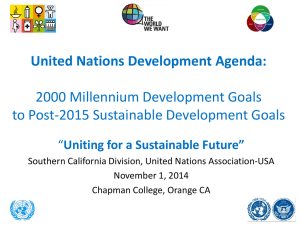Integrated Assessment Tools for Mainstreaming
advertisement
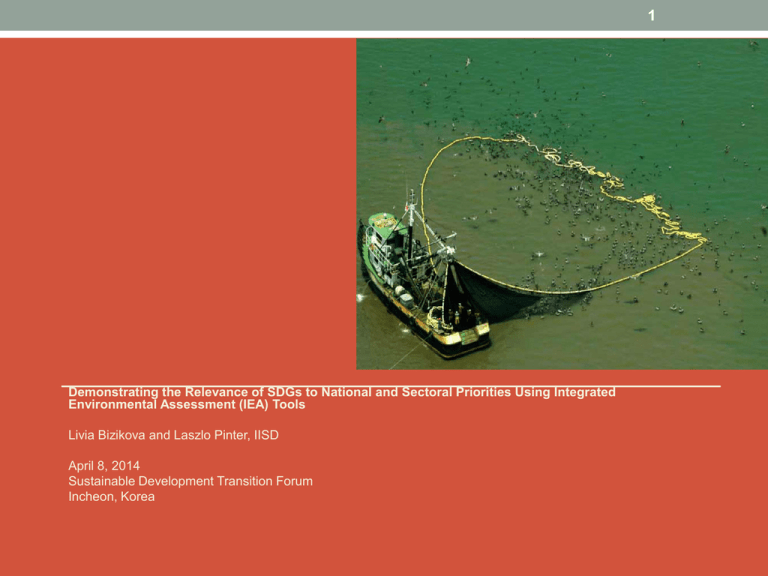
1 Demonstrating the Relevance of SDGs to National and Sectoral Priorities Using Integrated Environmental Assessment (IEA) Tools Livia Bizikova and Laszlo Pinter, IISD April 8, 2014 Sustainable Development Transition Forum Incheon, Korea 2 Session overview • Introduction and opening slides (20 min) • Plenary discussion on linkages between SD priorities/goals and development strategies (20 min) • DPSIR and SD goals (slides and plenary/group activity) (30 min) • SD goals and indicators (slides and plenary activity) (30 min) • Policies and communicating relevant for the SD goals (slides and group activity) (20 min) 3 Project overview • Building on UNEP/IISD GEO/IEA training • • • • program started around 2000 Longer-term project started in 2009 and ended in July 2013; Training module; 4 capacity-building events for medium-level decision makers (approx. 145 people) in 2 countries and 2 regional events Training module and its revisions (2011 and 2013); review paper, submitted journal paper Future projects on TOT, national trainings, data support documents 4 Rationale for this session • Regarding National Development Plans ..... • Tend to be driven by consultants rather than consultations • Silo structure with sectoral goals and objectives → lost opportunities for synergies and integration • Short term planning horizon, usually tied to the political business cycle • Increasingly responsive to global sustainable development agendas → hence opportunities to build synergies with SD priorities and goals 5 Rationale for this session • Regarding implementation….. “Tendency not to take on a specific SD goal due to perception it belongs to a single Ministry and not relevant to others” “What is the national development plan and how does the goal fit into it. Need to show that the goal fits into the plan and is not additional work.” “They need to highlight what the national benefit is of the SD goals. The minister needs to see how and why it is good for the country” 6 Approaches to mainstreaming • Mainstreaming helps enhance the policy development targeting agreements, key issues by increasing policy coherence, addressing trade-offs and capturing the opportunities for synergistic results in terms of meeting social, economic and environmental priorities • An informed inclusion of relevant concerns (adaptation, environment) into the decisions of institutions that drive national, local and sectoral development policy, rules, plans, investment and action. • In this respect, the understanding of mainstreaming is close to “integration” or “reciprocal mainstreaming”, indicating that both the context and the development aims are considered as important as environmental/adaptation aims, and that all three aspects should closely interact (Dalal-Clayton & Bass, 2009). 7 Active policy-makers • Surveys by Maiello et al. (2013) showed that managers and policy-makers rely on knowledge provided by external experts and collaboration with peers and other stakeholders. • Limited capacity of policy-makers to bridge domains (Naylor et al., 2012) and integrate different types of knowledge and across different stakeholders’ group • A critical process when focusing on mainstreaming is thus increasing the capacities of policy-makers to act as active “integrators” and transcend the boundaries of their sectors and agencies (Feldman and Kademian, 2007). • Such active roles could be strengthened by improving the capacities and competences of integrators by recognizing and institutionalizing more flexible mechanisms in collaboration and interactions (van Buuren & Edelenbos, 2004; Cornell et al., 2013). 8 MEAs • Convention on Biological Diversity (CBD) • Protocol Concerning Specially Protected Areas and Wildlife to the Convention for the Protection and Development of the Marine Environment of the Wider Caribbean Region (SPAW) • Convention on International Trade in Endangered Species of Wild Fauna and Flora (CITES) • The Convention on Wetlands -- "Ramsar Convention“ 9 Examples of SD goal proposals Theme Goal Subgoal Goal 8. Energy and climate change Climate change is effectively addressed while access to clean and sustainable energy is significantly improved 8.1. Everyone has access to sufficient energy and consumption is efficient and sustainable 8.2. The generation of clean and sustainable renewables has increased. 8.3. The rate of GHG concentration increase in the atmosphere has been reduced Improve farming practices, rural infrastructure, and access to resources for food production to increase the productivity of agriculture, livestock and fisheries, raise smallholder incomes, reduce environmental impacts, promote rural prosperity, and ensure resilience to climate change 6.a. Ensure sustainable food production systems with high yields and high efficiency of water, soil nutrients, and energy, supporting nutritious diets with low food losses and waste 6.b. Halt forest and wetland conversion to agriculture, protect soil resources, and ensure that farming systems are resilient to climate change and disasters 6.c. Ensure universal access in rural areas to basic resources and infrastructure services (land, water, sanitation, modern energy, transport, mobile and broadband communication, agricultural inputs and advisory services) (Source: ASEF Small Planet report) Goal 6: Improve agriculture systems and raise rural prosperity (Source: SDSN) 10 IMPLEMENTATION AND REPORTING #1 Clarify Focal SDG, Status and Linkages with Development Priorities Tool #6: Policy Planning Brief [Day 4 am] Tool #5: Policy Stress Testing using Existing Scenarios [Day 3 pm] Tool #1: Priorities Mapping using Ecosystem Wellbeing Linkages [Day 1 am/pm] #2 Identify #6 Prepare Policy Planning Brief SDG Outcome Planning #5 Assess Risks and Opportunities and Improve and Adapt as Necessary Steps in the process Synergies Among Focal SDGs [Day 2 am] #3 Articulate Desired Future Outcomes #4 Identify Portfolio of Policies for Achieving Future Outcomes Tool #2: Synergy Mapping using DPSIR Analysis Tool #4: Policy Mapping and Back-casting [Day 3am] Tool #3: Setting the Challenge Scenario [Day 2 pm] 11 Tool #1 Priorities Mapping Map the connections between the subgoals of the SDGs and the elements of a selected national priority SDG1 SDG Subgoal Water availability and access: Safe and affordable water is provided for all and the integrity of the water cycle is ensured 9.1. Water consumption of households and all economic sectors is efficient and sustainable 9.2. Infrastructure is available and well maintained to ensure a sufficient and safe water supply 9.3. The integrity of the water cycle has been achieved through widespread adoption of integrated water resources management Sector priorities or SDG2 Priority elements National / sector development priority Maternal health Human health Healthy lifestyles ? Universal access to sanitation … … … 12 Tool #1 Priorities Mapping Map the connections between the subgoals of the SDGs and the elements of a selected national priority SDGs SDG Subgoal Development Priority Priority elements National / sector development priority 14 IMPLEMENTATION AND REPORTING #1 Clarify Focal SDGs, Status and Linkages with Development Priorities Tool #6: Policy Planning Brief [Day 4 am] Tool #5: Policy Stress Testing using Existing Scenarios [Day 3 pm] SDG Outcome Planning #5 Assess Risks and Opportunities and Improve and Adapt as Necessary Mapping using Ecosystem Wellbeing Linkages [Day 1 am/pm] #2 Identify #6 Prepare Policy Planning Brief Tool #1: Priorities Synergies Among Focal SDGs [Day 2 am] #3 Articulate Desired Future Outcomes #4 Identify Portfolio of Policies for Achieving Future Outcomes Tool #2: Synergy Mapping using DPSIR Analysis Tool #4: Policy Mapping and Back-casting [Day 3am] Tool #3: Setting the Challenge Scenario [Day 2 pm] 15 Knowledge gained from data is fundamental to our understanding of environmental/socio-economic issues as well as for communicating information to policy-makers and other groups in society. Without good quality, relevant data and indicators, assessments/recomendations loses not only valuable communication tools, but also credibility and the ability to measure progress towards sustainability goals and objectives. UNEP (2008); IEA, Module 4 16 Small Planet SDG indicators: Health and Population 17 IMPLEMENTATION AND REPORTING #1 Clarify Focal SDGs, Status and Linkages with Development Priorities Tool #6: Policy Planning Brief [Day 4 am] Tool #5: Policy Stress Testing using Existing Scenarios [Day 3 pm] SDG Outcome Planning #5 Assess Risks and Opportunities and Improve and Adapt as Necessary Mapping using Ecosystem Wellbeing Linkages [Day 1 am/pm] #2 Identify #6 Prepare Policy Planning Brief Tool #1: Priorities Synergies Among Focal SDGs [Day 2 am] #3 Articulate Desired Future Outcomes #4 Identify Portfolio of Policies for Achieving Future Outcomes Tool #2: Synergy Mapping using DPSIR Analysis Tool #4: Policy Mapping and Back-casting [Day 3am] Tool #3: Setting the Challenge Scenario [Day 2 pm] 18 Example – Telling an Integrated Story HUMAN SOCIETY DRIVERS Step 1 Population growth PRESSURES IMPACTS Step 2 Step 1 Direct influence through human interventions Agriculture Sewage Discharge well-being RESPONSES Step 3 N and P regulation Infrastructure Bottle water STATE AND TRENDS Erosion - Access to clean water - Nourishment - health Services - Fresh water - Food - Recreation Step 1 River water quality– declining ENVIRONMENT Step 1 What is happening to the environment and why? Step 2 What are the consequences for the environment and humanity? Step 3 What is being done and how effective is it? 19 Creating a Policy Map – A System Perspective DRIVERS Indirect influence through human development PRESSURES IMPACTS Policy 1 Policy 2 Anthropogenic and natural Aspects of human wellbeing Policy 3 Sectors Policy 4 SDGs Policy Map Policy 8 Policy 7 Human influences Natural processes Policy 5 Policy 6 STATE and TRENDS What is the key environment state addressed by the SDGs? Ecosystem services impacted 20 Creating a Policy Map – Example DRIVERS Urban Growth Job creation incentives PRESSURES Sewage Discharge Spatial development regulations Food imports Infrastructure expenditures Sectors SDGs Policy Map Human influences Natural processes Sewer charges Water quality standards STATE and TRENDS River Water Quality In-situ treatment Water imports IMPACTS Nutrition and hydration Livelihoods Recreational and Cultural enjoyment Decreased fish catches Less drinking water 21 Developed by: Lisa Benjamin (Bahamas), Samuel Carrette (Dominica), Michelle Walters (St. Kitts and Nevis), Laverne Walker (St. Lucia), Christopher Roberts (CEHI) and Jason Williams (Antigua and Barbuda) 22 Creating a Policy Map – A System Perspective DRIVERS Indirect influence through human development PRESSURES IMPACTS Anthropogenic and natural Aspects of human wellbeing Sectors SDGs Policy Map Human influences Natural processes STATE and TRENDS What is the key environment state addressed by the SDGs? Ecosystem services impacted 23 IMPLEMENTATION AND REPORTING #1 Clarify Focal SDGs, Status and Linkages with Development Priorities Tool #6: Policy Planning Brief [Day 4 am] Tool #5: Policy Stress Testing using Existing Scenarios [Day 3 pm] SDG Outcome Planning #5 Assess Risks and Opportunities and Improve and Adapt as Necessary Mapping using Ecosystem Wellbeing Linkages [Day 1 am/pm] #2 Identify #6 Prepare Policy Planning Brief Tool #1: Priorities Synergies Among Focal SDGs [Day 2 am] #3 Articulate Desired Future Outcomes #4 Identify Portfolio of Policies for Achieving Future Outcomes Tool #2: Synergy Mapping using DPSIR Analysis Tool #4: Policy Mapping and Back-casting [Day 3am] Tool #3: Setting the Challenge Scenario [Day 2 pm] 24 Policy Stress Testing • To identify key policy performance risks and uncertainties • • • • • that could prevent achievement of SDGs To identify key opportunities To improve and adapt the portfolio of policies as necessary to ensure maintain progress toward SDGs Idea of policy stress testing is to identify key factors that impact on policy performance Then examine policy performance under plausible future conditions that consider the most important and uncertain factors Can use existing scenario information to do this 25 GEO LAC 3 Scenarios: 26 GEO LAC 3 Scenarios Relegated Sustainability Sustainability Reforms GEO 4 Scenarios Unsustainability and Increased Conflicts Transition to Sustainability 27 Stress Test Questtions • Risks: Is achievement of your desired SDG target(s) at risk given the plausible future conditions outlined in the scenario? If so, what factors are likely to have the most impact, and how? What adaptations for the portfolio of SDG policies are necessary to mitigate against the potential risks? • Opportunities: What opportunities does the scenario present for achieving your desired SDGs target(s) that have not yet been considered? What actions are necessary for the portfolio of SDG policies to be able to leverage the opportunities that may present themselves in the future? 28 IMPLEMENTATION AND REPORTING #1 Clarify Focal SDGs, Status and Linkages with Development Priorities Tool #6: Policy Planning Brief [Day 4 am] Tool #5: Policy Stress Testing using Existing Scenarios [Day 3 pm] SDG Outcome Planning #5 Assess Risks and Opportunities and Improve and Adapt as Necessary Mapping using Ecosystem Wellbeing Linkages [Day 1 am/pm] #2 Identify #6 Prepare Policy Planning Brief Tool #1: Priorities Synergies Among Focal SDGs [Day 2 am] #3 Articulate Desired Future Outcomes #4 Identify Portfolio of Policies for Achieving Future Outcomes Tool #2: Synergy Mapping using DPSIR Analysis Tool #4: Policy Mapping and Back-casting [Day 3am] Tool #3: Setting the Challenge Scenario [Day 2 pm] 29 Policy Brief Template (max 2 pages) 1. Key SDG commitments and their relevance to national development priorities: ...[summarize results from Tool #1 Priorities Mapping]… 2. Synergies and Important Stakeholders within and outside of government: … [summarize the results of Tool #2 Synergies Mapping]… 3. Possible future SDG outcome targets: …[summarize the results of Tool #3 Policy Mapping]… 4. Existing Policy Inventory and Recommendations: …[summarize the results of Tool #4 5. Risks and Opportunities for Achieving Outcomes: ….[summarize the results of Tool #5 Policy Stress Testing]…
